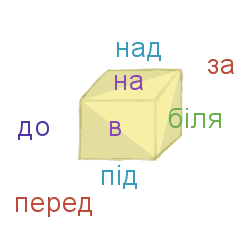1-10
1 — один, одна, одне*
2 — два, дві**
3 — три
4 — чотири
5 — п'ять
6 — шість
7 — сім
8 — вісім
9 — дев'ять
10 — десять
1 — один, одна, одне*
2 — два, дві**
3 — три
4 — чотири
5 — п'ять
6 — шість
7 — сім
8 — вісім
9 — дев'ять
10 — десять
Numerals are devided into cardinals (cardinal numerals) and ordinals (ordinal numerals).
In turn cardinals are divided into:
basic cardinals: нуль (zero), один (one), два (two), три (three), чотирнадцять (fourteen), сто десять (hundred and ten), тисяча (thousand) etc.
fractions: одна шоста (1/6), дві сьомих (2/7), пів (half), півтора (one and a half) etc.
assembled: двоє (two), четверо (four), п'ятеро (five) etc.
undesignated cardinals: багато (many/much), мало (few/little), кілька (few/little) etc.
Ordinal numerals are formed by adding endings -ий/ій, -а/я, -е/є, -і to the corresponding cardinal numerals depending on the gender and number, which makes them look like adjectives of hard and soft groups.
For example:
дванадцять (twelve) + ий = дванадцятий (twelfth): masculine, singular;
дванадцять (12) + а = дванадцята (12th): feminine , singular;
дванадцять (12) + е = дванадцяте (12th): neuter , singular;
дванадцять (12) + і = дванадцяті (12th): plural.
The adverb is an unchangable part of speech that defines means of action, state or other means.
Unlike other independent parts of speech (e.g. the noun or adjective) the adverb does not have genders, declensions, singular or plural forms.
Adverbs are created by changing other parts of speech like nouns, adjectives and pronouns.
For example:
ніч (night) — вночі (at night): noun — adverb
швидкий (quick) — швидко (quickly): adjective — adverb
мій (my) — по-моєму (roughly means "as for me"): pronoun — adverb
Adverbs can be divided in two main groups:
Adverbs of quality, quantity and manner.
Adverbs of time, place, intention and cause.

When telling the location of or destination to a particular object you may encounter some difficulties with what preposition to use or how to change the noun according to it.
In this article I will show you the most popular prepositions and their common usage.
Here are some main points of telling the location and destination:
depending on the preposition and the question put to the sentence there can be 4 different cases involved in: Genitive, Accusative, Instrumental, Locative;
Locative case is never involved in telling the destination, it can only point on the location of an object.
Ukrainian adjectives have two degrees of comparison: comparative and superlative. Every degree has as well two forms: simple and hard.
First of all I would like to note that for beginners or even more advanced Ukrainian speakers the "simple" form is actually more difficult to understand and learn than the "hard" form. So feel free to use the easiest form because they both are interchangeable, though we prefer to use "hard" form with more abstract or relative adjectives.
Depending on the consonant before the ending adjectives can be divided into two groups:
hard group:
the hard consonant before -ий ending: добрий (kind), червоний (red), чистий (clean), низький (short);
all the possessive adjectives: мамин (mother's), батьків (father's);
soft group:
the soft consonant before -ій, синій (dark blue), ранній (early), колишній (former, ex), справж ній (true);
adjectives with -їй ending: безкраїй (immense, endless).
and a special group of adjectives with -ций ending, which is a part of -лиций (“лице” means “face”): груглолиций (round-faced), блідолиций (pale-faced).
The adjective (прикметник [prɪk'mɛtnɪk]) is a part of speech which defines the subject and answers the question: “який?” “яка?” “яке?” (which?/what?/what kind?) and “чий?” “чия?” (whose?).
The adjectives can define:
colour: білий (white), чорний (black), блакитний (blue);
size: великий (big), малий (small, little), широкий (wide), вузький (narrow);
age: молодий (young), старий (old);
flavour: солодкий (sweet), кислий (sour);
The fourth declension includes neuter nouns with -а(-я) endings, which after declension achieve ен-, -ат-, -ят- suffixes.
Similar to the third declension it does not have groups (still the first and second declensions have them).
Neuter nouns with -а(-я) endings that mostly mean little animals or names of undersized things get the -ат-,-ят- suffixes: курча (a chicken) — курчати, кошеня (a kitten) — кошеняти, ягня (a lamb) — ягняти, немовля (a newborn baby) — немовляти etc.
The third declension includes feminine nouns with zero endings and the word “мати” (a mother).
It does not have groups like the first and second declensions and thus is easier to deal with. Many feminine nouns from this group mean something abstract, object's quality, condition, action or even some general concepts. These nouns often cannot have plural form.
Example: сміливість (courage), гордість (pride), любов (love), щастя (happiness), мудрість (a wisdom), радість (a joy) etc.
The second declension includes masculine nouns with zero and -о endings and neuter nouns with -о,-е,-я endings.
These nouns are divides in three groups: hard, soft and mixed. In The Noun: Declensions article it was explained which nouns belong to each of these groups, so now it is time to learn how to change the nouns according to the cases and their groups.